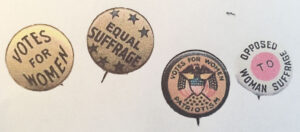Editor’s note:This is the second of a series of stories The Citizen will publish during Women’s History Month a celebration of women’s accomplishments and contributions celebrated in the month of March.
By Shelby Stewart
Staff Writer
An local collector recently shared some century old political pins from his collection reflecting a dynamic time in history for women and voting rights. 
“These go for a lot of money,” said Ken Bush, an Ortonville resident. “These can go for $100, easily.”
Most of the buttons he has on the subject are for women’s right to vote, usually saying ‘Votes for Women,’ but he also has a button that opposes women’s suffrage.
“Throughout U.S. history there have been a variety of arguments put forth by those seeking to deny women the right to vote,” said Julie Walters, J.D., Ph.D., associate professor at Oakland University.
Walters listed many reasons that there was an opposition to women’s suffrage, including the thought that once a woman was married her vote was represented by her husband, that a women’s place was in the home and not in politics because it was a dirty business, that women were too busy caring for children to keep up with politics or vote, that women voting would mean the decay of the American family and society, and that women simply didn’t want to vote.
“Though there were individual women advocating for women’s suffrage in the early years of the United States, the first substantial push forward by a large, well-organized group involved a women’s rights convention held in Seneca Falls, NY (1848),” said Walters. “Attendees discussed and planned for advocacy on the rights of women in the political, governmental, social, and religious spheres of life. With the right to vote being a critical component of citizenship, it was a prominent feature of the convention as female citizens of the country did not have the right to vote yet they were subject to laws passed by those elected by male citizens. ‘Taxation without representation,’ a familiar protest during colonial times, was also invoked here.”
The pins that Bush has date back to the early 1900s, prior to women gaining the right to vote in 1920.
“There are so many amazing women who were integral to the fight for women’s suffrage, from Susan B. Anthony to Alice Paul to the thousands of women whose names are not documented in history. Many founded and led key advocacy organizations such as the National American Woman Suffrage Association and the National Woman’s Party,” said Walters. “Similar to today’s advocacy, advocates at the local and state levels were critically important in all of the decades women fought for the right to vote. Creating their own publications, writing into newspapers, organizing various speaking events, and engaging in street-speaking were among a number of important activities of advocates. These activities complemented lobbying efforts of wealthy supporters of the movement and leaders of the National American Woman Suffrage Association (NAWSA) and later the National Woman’s Party and other groups to educate politicians on the cause.”
Walters also said that in March of 1913, the day before the inauguration of Woodrow Wilson, the NAWSA organized a Women’s Suffrage Procession to march down Pennsylvania Avenue in support of women’s right to vote.
“Starting in January of 1917 and extending for two years, members of the National Woman’s Party silently protested (with banners) in front of the White House,” said Walters. “Known as Silent Sentinels or Sentinels of Liberty, they were present 6 days of the week in all weather. Though they never spoke a word as part of the protest, their banners carried powerful messages about freedom, liberty, and women’s suffrage. Color was also an identifying characteristic of women’s suffrage as was seen in their banners of purple, gold, and white.”
Like the pins, which showed support of ‘Equal Suffrage’ and ‘Votes for Women’, the banners had messages such as ‘Mr. President, how long must women wait for liberty?’ and ‘Forward out of error, leave behind the night, forward through the darkness, forward into light.’
Though many protests were civil and peaceful, many suffragettes were arrested, imprisoned, and physically and mentally abused.
“They endured aggression from those who opposed their call for voting rights – from various businesses, government, and individuals. Violence was not unfamiliar to them and verbal as well as written abuses could be encountered in daily life, not just during a parade and/or protest,” she said. “Women’s suffrage meant 50 percent of the country, previously prohibited from voting, could now vote. It was the culmination of informal and formal advocacy for well over 100 years. It may not have involved military weaponry but there is no doubt, women’s right to vote is the result of a fight.”
